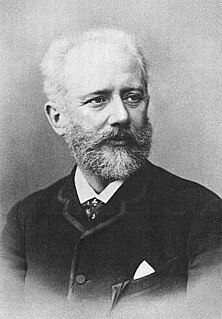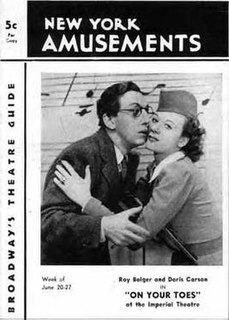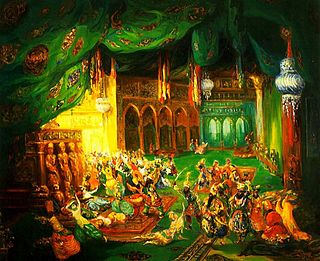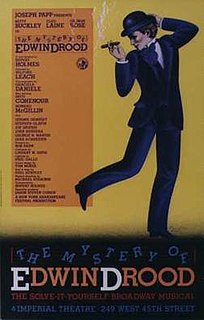Related Research Articles

Magical Maestro is a 1952 American animated short comedy film directed by Tex Avery and produced by Fred Quimby for Metro-Goldwyn-Mayer. It features the Great Poochini, a canine opera singer who spurns a magician. The magician is able to replace Poochini's normal conductor prior to the show through disguise. In 1993, Magical Maestro was selected for preservation in the United States National Film Registry by the Library of Congress as being "culturally, historically, or aesthetically significant", making it the only Tex Avery cartoon so far to be inducted.

The Rite of Spring is a ballet and orchestral concert work by the Russian composer Igor Stravinsky. It was written for the 1913 Paris season of Sergei Diaghilev's Ballets Russes company; the original choreography was by Vaslav Nijinsky with stage designs and costumes by Nicholas Roerich. When first performed at the Théâtre des Champs-Élysées on 29 May 1913, the avant-garde nature of the music and choreography caused a sensation. Many have called the first-night reaction a "riot" or "near-riot", though this wording did not come about until reviews of later performances in 1924, over a decade later. Although designed as a work for the stage, with specific passages accompanying characters and action, the music achieved equal if not greater recognition as a concert piece and is widely considered to be one of the most influential musical works of the 20th century.

A proscenium is the metaphorical vertical plane of space in a theatre, usually surrounded on the top and sides by a physical proscenium arch and on the bottom by the stage floor itself, which serves as the frame into which the audience observes from a more or less unified angle the events taking place upon the stage during a theatrical performance. The concept of the fourth wall of the theatre stage space that faces the audience is essentially the same.

The Hollywood Bowl is an amphitheatre in the Hollywood Hills neighborhood of Los Angeles, California. It was named one of the 10 best live music venues in America by Rolling Stone magazine in 2018.

Swan Lake, Op. 20, is a ballet composed by Pyotr Ilyich Tchaikovsky in 1875–76. Despite its initial failure, it is now one of the most popular ballets of all time.

The Nutcracker is an 1892 two-act ballet, originally choreographed by Marius Petipa and Lev Ivanov with a score by Pyotr Ilyich Tchaikovsky. The libretto is adapted from E. T. A. Hoffmann's story "The Nutcracker and the Mouse King".

William Grant Still Jr. was an American composer of nearly 200 works, including five symphonies, four ballets, nine operas, over thirty choral works, plus art songs, chamber music and works for solo instruments.

Peter and the Wolf Op. 67, a "symphonic fairy tale for children", is a musical composition written by Sergei Prokofiev in 1936. The narrator tells a children's story, while the orchestra illustrates it. It is Prokofiev's most frequently performed work and one of the most frequently performed works in the entire classical repertoire. It has been recorded many times.

Parade is a ballet with music by Erik Satie and a one-act scenario by Jean Cocteau. The ballet was composed in 1916–17 for Sergei Diaghilev's Ballets Russes. The ballet premiered on Friday, May 18, 1917 at the Théâtre du Châtelet in Paris, with costumes and sets designed by Pablo Picasso, choreography by Léonide Massine, and the orchestra conducted by Ernest Ansermet.

Coppélia is a comic ballet originally choreographed by Arthur Saint-Léon to the music of Léo Delibes, with libretto by Charles-Louis-Étienne Nuitter. Nuitter's libretto and mise-en-scène was based upon two stories by E. T. A. Hoffmann: Der Sandmann. In Greek, κοπέλα means young woman. Coppélia premiered on 25 May 1870 at the Théâtre Impérial de l'Opéra, with the 16-year-old Giuseppina Bozzacchi in the principal role of Swanhilda and ballerina Eugénie Fiocre playing the part of Frantz en travesti. The costumes were designed by Paul Lormier and Alfred Albert, the scenery by Charles-Antoine Cambon, and Édouard Desplechin and Jean-Baptiste Lavastre.

The Little Rascals is a 1994 American family comedy film produced by Amblin Entertainment, and released by Universal Pictures on August 5, 1994. The film is an adaptation of Hal Roach's Our Gang, a series of short films of the 1920s, 1930s, and 1940s which centered on the adventures of a group of neighborhood children. The film, with a screenplay by Paul Guay, Stephen Mazur, and Penelope Spheeris – who also directed – presents several of the Our Gang characters in an updated setting, and features re-interpretations of several of the original shorts. It was the first collaboration by Guay and Mazur, whose subsequent comedies were Liar Liar and Heartbreakers.

Petrushka is a ballet and orchestral concert work by Russian composer Igor Stravinsky. It was written for the 1911 Paris season of Sergei Diaghilev's Ballets Russes company; the original choreography was by Michel Fokine and stage designs and costumes by Alexandre Benois, who assisted Stravinsky with the libretto. The ballet premiered at the Théâtre du Châtelet on 13 June 1911 with Vaslav Nijinsky as Petrushka, Tamara Karsavina as the lead ballerina, Alexander Orlov as the Moor, and Enrico Cecchetti the charlatan.

The Théâtre des Champs-Élysées is an entertainment venue standing at 15 avenue Montaigne in Paris. It is situated near Avenue des Champs-Élysées, from which it takes its name. Its eponymous main hall may seat up to 1,905 people, while the smaller Comédie and Studio des Champs-Élysées above the latter may seat 601 and 230 people respectively.

On Your Toes (1936) is a musical with a book by Richard Rodgers, George Abbott, and Lorenz Hart, music by Rodgers, and lyrics by Hart. It was adapted into a film in 1939.

Harringay Arena was a sporting and events venue on Green Lanes in Harringay, North London, England. Built in 1936, it lasted as a venue until 1958.

Scheherazade, also commonly Sheherazade, Op. 35, is a symphonic suite composed by Nikolai Rimsky-Korsakov in 1888 and based on One Thousand and One Nights.

The Mystery of Edwin Drood is a musical based on the unfinished Charles Dickens novel. Written by Rupert Holmes, the show was the first Broadway musical with multiple endings. The musical won five Tony Awards out of eleven nominations, including Best Musical. Holmes received Tonys for Best Book of a Musical and Best Original Score.
EFX was a Las Vegas Strip production show residing at the MGM Grand Hotel & Casino which opened on March 23, 1995 and closed on December 31, 2002. When it premiered, it was the most expensive and largest-scaled theater installation in the world. A significant entertainment landmark of the strip for nearly eight years, it was known for changing its headline star every two years. Performers in the lead role were Michael Crawford, David Cassidy, Tommy Tune, and Rick Springfield.
Mercure is a 1924 ballet with music by Erik Satie. The original décor and costumes were designed by Pablo Picasso and the choreography was by Léonide Massine, who also danced the title role. Subtitled "Plastic Poses in Three Tableaux", it was an important link between Picasso's Neoclassical and Surrealist phases and has been described as a "painter's ballet."

Slow Beau is a 1930 short animated film distributed by Columbia Pictures, starring Krazy Kat. The film also marks the debut of Krazy's second theme song which would have a much longer run than his first.